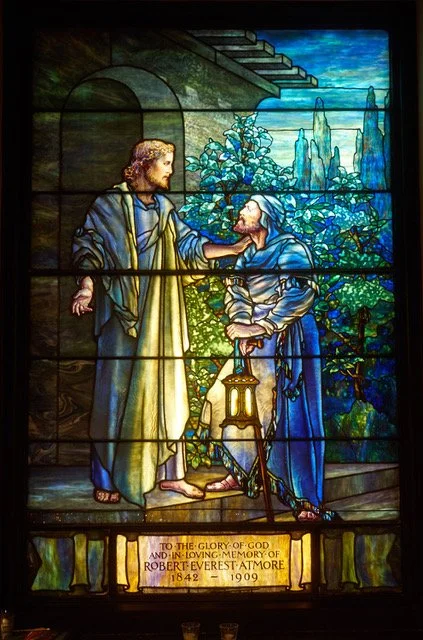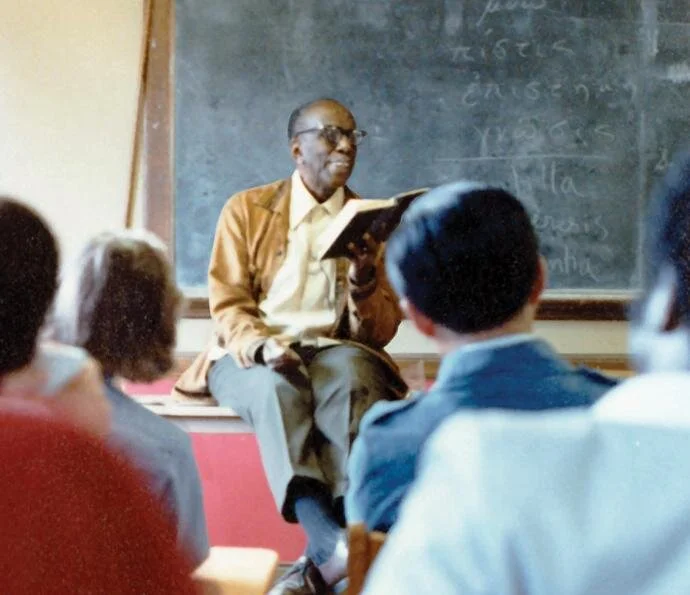On Howard Thurman (1899-1981) and a Spirituality of the Here and Now – Part II
Don’t ask what the world needs. Ask what makes you come alive and go do it. Because what the world needs is people who have come alive.
—Howard Thurman, from The Living Wisdom of Howard Thurman: A Visionary for Our Time
Howard Thurman Collection, Howard Gotlieb Archival Research Center, Boston University
I. The first part of this Friday Reflection (from September 10), introduced us to Howard Thurman and to the way he lived his life as an “authentic contemplative who struggled with the contemporary world, with what Thomas Merton described as the world of action. My initial reflection focused on a distinctive element: Thurman was committed to “contemplative non-violence.” The question for us in this second part, then, is how a committed Black minister, who was called “the saint” of the civil rights movement, could make his way as a civil rights teacher, preacher, mentor, and contemplative in a violent and racist world. How could Howard Thurman, as the person he was, exist in and serve such a world? But more importantly, how could Howard Thurman live successfully in two such seemingly differentiated worlds: one of contemplation and the other of action?
II. There is no one answer to this question, but we can identity several elements that, taken together, might explain a great deal. Recently, I discovered another Thurman quote which can guide us here: “What happens to you won’t destroy you, unless you allow it to get in you.” (quoted in the “Living Word” column for the October 16, 2016 issue of The Christian Century.) These words affirm what Thurman believed about the importance of one’s spiritual life and how the strength of that life is so essential to self-understanding, authenticity and staying alive morally. Thurman knew well that the “here and now” of our lives is filled with daily joys, sorrows, and travails. Thurman also knew how the very battle for civil rights and the dignity of all people carried the power to “destroy” those committed to these goals and believed we need to have a strong and vital inner life of the Spirit to aid and support us if we are to avoid the perils of the “here and now.” And lastly, Thurman knew what he needed to do to withstand the pain and diminishment of what it meant to be as Black man in America.
III. Henri Nouwen’s notion of the spiritual life is useful for a fuller understanding of Howard Thurman’s convictions: that to sustain a spirituality of the here and now and avoid the difficult aspects of everyday life, especially as a Black man in America, we must be ever attentive to how we think, feel, speak, and act, in everything thing we do, and be guided by the Holy Spirit. Otherwise, the “bad stuff” will get to us and, in Thurman’s view, “destroy” us. Not to pray, meditate, or practice silence and solitude is all but to guarantee that the demands of “nonviolent resistance” to the evils of racism and segregation and the need for steadfast moral courage will not be met. And Thurman’s goal of “coming alive” will not happen.
Photo of Howard Thurman
IV. Howard Thurman was not an activist. He did not march, take part in demonstrations, or speak at public gatherings. Consequently, he was seen as somewhat of a disengaged academic and preacher, often accused of not going the extra mile in the streets on behalf of the oppressed and disenfranchised. But Thurman was a “spiritual activist” in his teaching, preaching, mentoring, and pastoring. In fact, I would argue that Thurman was a teacher in everything he did. He spoke as a teacher, wrote as a teacher, counseled as a teacher, and preached as a teacher, all from a deep conviction that his calling was to face down racial, religious, and social oppression. As he taught, preached, and wrote, Thurman affirmed reconciliation, contemplation, nonviolence, and the critical importance of mutual integrity.
V. And as much as he was a teacher, Howard Thurman was a student, always curious and ready to learn. He was a poet with artistic sensibilities, and his art was bringing new life to the language and liturgy of religion. Thurman believed, in fact, that a religious life was the life of the soul. He honored the importance of the individual religious experience, and, in this, he was ever an ecumenist.
VI. Howard Thurman once posed the question for himself, “to what am I true”? I would offer that Thurman was true to living his life as a morally responsible human being and as a Christian who followed Jesus. In Thurman’s important book Jesus and the Disinherited (1949), he argued that it is the disinherited, those whose “stand with their backs against the wall,” with whom Jesus identifies, who can teach the rest of us about pain and tolerance and show us the way out of violence and hatred. Thurman was true to standing with Jesus.
VII. Finally, we come to the troubling question of why Howard Thurman does not have a presence in the Episcopal Lectionary and why it appears he lacks formal recognition from the institutional Episcopal Church. While it is true that there is a sculpture of Howard Thurman in the National Cathedral in Washington D.C. as of 2006, and Howard Thurman was named Honorary Canon of the Cathedral of Saint John the Divine in New York City in 1974, there are no additional church-wide honors or recognitions of Thurman that I can find. Given his stature as a distinguished Black theologian, academic, preacher and churchman, and the fact that he is studied and read widely by church groups, seminaries, and schools of theology, one wonders if Howard Thurman was ever recognized at a General Convention and recommended to the Standing Commission on Liturgy and Music for inclusion in the Lectionary. Indeed, to this priest and blogger, this is a singular omission, as Thurman stands as a very powerful witness and one who embodies so much of what the Episcopal church is about. I pray that Thurman’s case for recognition in the Episcopal Lectionary will be taken up at the next General Convention (2022).
A special note: In 2019, the filmmaker Martin Doblmeier and Journey Films released Backs Against the Wall: The Howard Thurman Story. I mention this film not only because it is an excellent 56-minute survey of Howard Thurman’s life and work, but also because it is available for on-line viewing at no cost. If you have even a slight degree of interest in Howard Thurman’s legacy, please take the time to view this film (below).
—Father Peter









